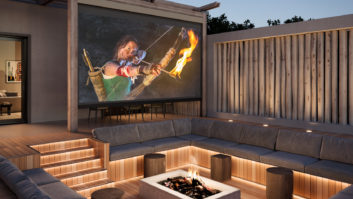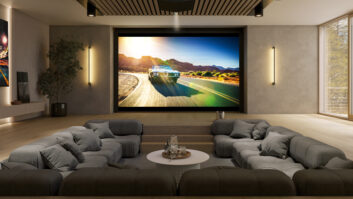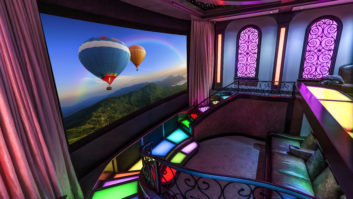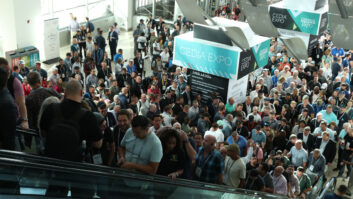These days the world is full of trends. Take mobile communication devices, for example. Remember when we used to simply call them cell phones? We cant anymore because some take messages, some send messages, some take pictures, some play music, some surf the Internet, some send/receive e-mail, and some organize your life. I even saw one phone advertised the other day thats not really a phone at all. Its a camera, MP3 player, PDA, and hi-speed Internet interface, but youre out of luck if you actually want to talk to someone.
While the general public is battling the burgeoning telecommunications industry, the custom installation industry is waging its own trend war on projection screens. As with any new trends, some screen trends are great and some are potentially hazardous. Lets take a quick look at the current state of affairs before someone tries to sell us a screen that does everything but display an image.
Acoustically transparent screens are all the rage in home theater, and for good reason. Dubbing stages (movie mix rooms) and cinemas all have acoustically transparent screens hiding the three screen speakers. Besides making a home theater look more like the real thing, an acoustically transparent screen has other advantages. Placing the center speaker behind the screen is very important for sound-to-picture correlation. Having a voice come from a spot three feet above or below an actor is distracting. Further, the left, center, and right speakers will only create an ideal soundstage when theyre all at the same height. And lets not forget how much better the center speaker sounds when its away from boundaries like the floor and ceiling.
Unfortunately, perforated screens exhibit lower gain and objectionable moir patterns when theyre used in conjunction with fixed-pixel projectors. On the, um, bright side, new fabric screens have eliminated the moir problem, and most bulb projectors have very little trouble overcoming the loss of light through the screen. You still have to control the light that passes through the screen, though. The area behind the screen needs to be non-reflective black, or else youll need to put a black backing (also acoustically transparent) on the screen itself.
Another hot trend is the gray screen. Gray screens were originally intended to lower blacks in LCD and DLP projectors with poor dark resolution. The visual resolution of most early-generation fixed-pixel devices was poorin the 0 IRE to 20 IRE region. It was customary to bury the dark portions of the picture into a uniform black with no detail to hide the fact that blacks and dark grays were displayed identically. Gray screens are now used for lowering perceptible ambient light reflections off the screen. Of course the black levels from the projector are lowered, too, but that is corrected by turning up the brightness, preferably using a PLUGE test pattern to nail the exact level of black cutoff.
Peak white levels are also diminished by the gray screen tone. This is considered by many to be an acceptable compromise since human eyes are more sensitive to detail in blacks than whites and since a loss of 6dB of light (50 percent light level) is not really detrimental to the enjoyment of a movie.
With a reflective coating adding reflectance beaming (a.k.a. gain) to a gray screen, the peak white levels from a projector off a gray screen can be perceivably the same as a white screen with no coating. Additionally, a directional coating will result in rejection of off-axis light. Therefore, the black picture detail in rooms with some ambient light or with light-colored surfaces will be improved, leading to perceivably better contrast ratios.
But screens with a reflective coating almost inevitably suffer from hot spots in the image. Hot spots occur when the screen illumination is uneven as seen from the viewing position. On a screen with mild directivity they arent too problematic, but once the reflective coating corresponds to a gain increase of two or greater, the hot spot will be plainly visible on bright scenes. Look for an area of brighter image in the middle of the screen, with a gradual falloff as you move to the edges of the image.
As stated earlier, a gray screen causes lower brightness. Directivity-enhancing coating helps recover the light levels, but the image quality invariably suffers to a certain degree. The ideal solution for high-performance screening rooms is to make them pitch dark and use dark tones for all the surfaces (walls, ceiling, floor, and furnishings).
Curved screens, which exist thanks to the super-cool, but short-lived Cinerama craze of the 1950s, have also started popping up in home theaters. Some people are of the opinion that curved screens have an enveloping feel that is more cinematic than a flat screen, although most cinema screens in the States today are, in fact, flat. Curved screens will focus more light back to the viewing area if the screen material is coated for directionality, so you get a brighter image. Aside from that, there are no real technical advantages to curved screens.
There are a number of potential drawbacks, however. With curved screens, picture distortion is a real possibility if the projector is not precisely on-axis with the screen. The picture can exhibit a serious hot spot. The concave nature of the screen will also focus sound reflections into a specific area, creating a hot spot of sound energy. The resulting imbalance of sound pressure in the room is very uncomfortable, as I recently experienced during a curved-screen presentation of Chicken Little in 3D. (I have a young daughter; whats your excuse?) The lower mids were excessively loud and the sound field was inaccurate. In the long run, its probably better to avoid curved screens entirely if you and your clients can possibly live without them.
The best advice for choosing a screen is to be cautious and know all the side effects of the various technologies. Remember that one type of screen will work better in one application and another type in another application. Then, of course, there are the screens that really dont work in any application. When trends run amok, things get complicated. Thats why clients pay you the big bucks. You can make the right decision for their application. Choose wisely.
Anthony Grimani is president of Performance Media Industries in Fairfax, California.
Chase Walton ([email protected]) contributed to this article.







